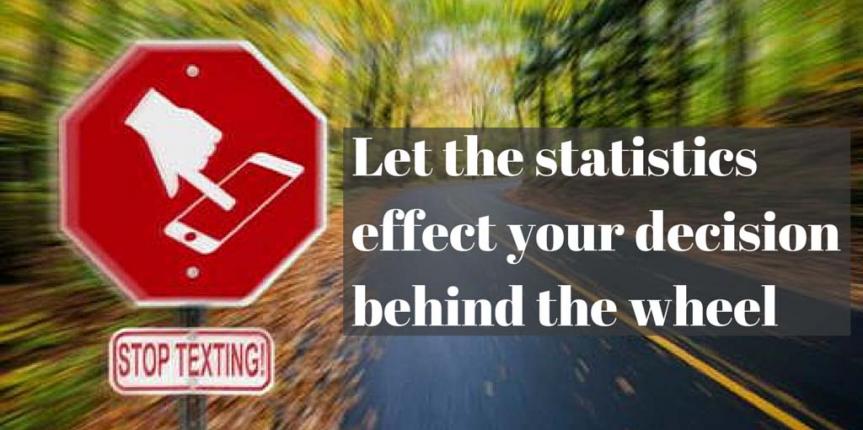Do Texting and Driving Accidents Effect Your Decisions Behind the Wheel
Updated article: Original publish date – November 7, 2014
Just about everybody believes that texting while driving is negligent behavior and has knowledge that it causes hundreds of thousands of vehicle accident injuries and deaths each year in this nation.
During 2016, 3,450 people died in crashes attributed to distracted drivers. In addition to that, 391,000 people received personal injuries from motor vehicle accidents caused by distracted drivers.
A current campaign aimed at reaching young drivers claims that distracted driving or texting while driving causes more deadly accidents than drunk driving. The problem is so serious that a campaign called “Stop Texts, Stop Wrecks” is sponsored by the Ad Council, in collaboration with NHTSA and the office of the State Attorneys General in a specific attempt to communicate this danger to young drivers and others.
Texting and Driving Accidents
As another busy holiday season approaches, with heavy traffic expected as people travel and shop, it is important for all drivers to give this problem some serious thought. The high rate of driving accidents caused because people are texting and not paying attention to the road ahead should affect the decisions made behind the wheel. Each year, texting and driving accidents kill thousands of innocent people and injure over 500,000 young adults, according to records kept by the National Highway Traffic Safety Administration (NHTSA).
The saddest fact about texting and driving accidents is that these injuries and deaths are completely preventable if people were not negligent in their behavior. The result of texting and driving accidents is pain, suffering, property damage, high medical expenses and often the wrongful death of loved ones. The responsible negligent drivers and their own passengers may also be injured or killed by this type of distracted driving.
Basic Facts about Texting and Driving Accidents
It is critically important that all drivers understand the facts about this problem and why they should not drive while texting. It is far better to turn off the devices or make a stop to do communicating when necessary than to try to multi-task when you are behind the wheel of any vehicle. Here are the top three basic facts reported in the Stop Texts, Stop Wrecks campaign that everybody should know:
- The average time it takes to divert your attention and eyes from the road ahead to do texting is five seconds. In that same time, your vehicle traveling at 55 mph will cover about 300 feet, the length of a football field. An accident can easily happen in that short time frame. If someone stupidly decides to pull their car over from a left turn lane in front of you to make a right turn instead, and you are diverted even for a second, a broadside collision can quickly occur.
- Just the mere act of reaching for, dialing or texting on a device like a cell phone or other portable device will increase your chance of a collision three times.
- Drivers under age 20 have the largest proportion of distracted drivers; 11% of drivers under age 20 were involved in fatal crashes due to distracted driving.
The Risk to You
Texting and driving accidents are a problem for everyone. The high incidence of accidents attributed to this negligent behavior means you, even as a safe and conscientious driver, are at risk of being injured or killed by another driver who is not paying attention to their driving skills and the road ahead. Car accident lawyers are kept busy, especially during busy traffic times like the holidays, pursuing justice and fair compensation for their clients who were injured or had loved ones killed by texting drivers.
Part of the problem is the widespread use of texting, especially by young adults and new drivers. In addition to lacking driving experience, when these youngsters are not focusing on their driving skills, it only takes a second or two of inattention to result in a collision.
It is estimated that 49% of drivers under the age of 35 who have cell phones are sending or reading text messages while they are driving. Use of cell phones for communication while driving runs even higher, at 60% of all drivers.
Compounding the real risks of texting while driving is the belief of younger drivers that they can safely do these activities without jeopardizing themselves or others while driving. This false confidence is even more prevalent among teenage drivers, who think it is easy to text while driving without an increased risk of a collision. On the other hand, about 80% of these same young drivers are concerned about this issue of texting and driving risk.
Solutions
There are solutions, including the current NTHSA and Ad Council awareness campaign. Several states have increased police patrols specifically with a mission to curtail driving while texting. Some employers have banned drivers from texting at work. Another option is to have someone else in the car do the texting and reading of messages for you.
Parents and other people with influence over younger drivers must communicate the seriousness of failing to pay full attention to driving. The simplest solution for each individual is to turn off communication devices and put them away, out of sight.






